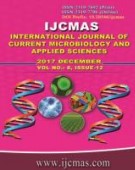


 National Academy of Agricultural Sciences (NAAS)
National Academy of Agricultural Sciences (NAAS)

|
PRINT ISSN : 2319-7692
Online ISSN : 2319-7706 Issues : 12 per year Publisher : Excellent Publishers Email : editorijcmas@gmail.com / submit@ijcmas.com Editor-in-chief: Dr.M.Prakash Index Copernicus ICV 2018: 95.39 NAAS RATING 2020: 5.38 |
Three aroma and non-aroma crops were raised separately as border crops in and around rice field (var. CO 51) to enhance the activity of predatory mirid bug, Cyrtorhinus lividipennis (Reuter) and to mitigate brown planthopper (BPH) Nilaparvata lugens (Stal). The aroma varieties viz., Pusa Basmati-1, Pusa Suganth and Jeeraga Samba, the non-aroma varieties viz., BPT 5204, ADT 36 and ADT 43 were used as border crops. Laboratory experiments were also conducted to study the orientation of C. lividipennis towards different leaf and flower sample of border crops through eight-armed olfactometer. Result revealed that mean field population of mirid bugs and BPH on rice crop varied from 3.24 to 7.24 and 1.88 to 4.82 per hill in the border cropped system. Rice + Pusa Basmati border cropping system significantly enhanced the population of C. lividipennis on rice (7.24/hill) along with highest occurrence ratio (1.16) with more CB ratio (1:1.50). This was followed by Rice + Pusa Suganth, Rice + Jeeraga Samba and Rice + BPT 5204 border cropping systems (6.97, 6.70 and 4.78 mirid bugs/hill on rice) respectively. Rice + ADT 43 border cropping system however recorded with less population of mirid bug (3.84 per hill on rice) and in rice alone had the population of 3.22 per hill. Similarly, populations of mirid bugs on border crops ranged from 2.18 to 8.38 per hill. Maximum mirid bug population (8.38/plant) was observed on Rice + Pusa Basmati border crop. Pusa Suganth and Jeeraga Samba registered 8.06 and 7.31 mirid bugs per plant respectively. This study concluded that Rice + Pusa Basmati and Rice + Pusa Suganth can be used as border crops in rice ecosystem to enhance the availability of mirid bugs. In olfactometer studies, mirid bug attraction was higher towards Pusa Basmati leaf (3.00) and flower (3.56) samples.
 |
 |
 |
 |
 |